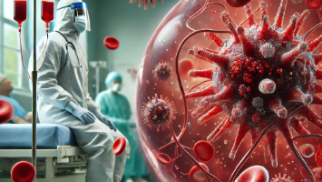Hemorrhagic fever


Hemorrhagic fevers are a group of infectious diseases that have in common being caused by viruses from different families. Its transmission requires a vector (tick, rodents or mosquitoes) and can give rise to very serious clinical manifestations with involvement of several organs and hemorrhagic symptoms.
What are they and where are they located
This group of fevers includes, but is not limited to:
- Crimean-Congo hemorrhagic fever.
- Ebola virus disease.
- Marburg hemorrhagic fever.
- Yellow fever
- Dengue.
- Lassa fever.
- Rift Valley Fever.
They differ basically in the transmitter vector type (ticks, rodents and mosquitoes), in their geographical distribution and in severity. There are fevers with a better prognosis such as Dengue and others with high mortality such as
Regarding their distribution in the world, they are located in certain regions from Eastern Europe (Balkans), Southeast Asia, the Middle East, Africa, Central and South America. Spain is not included in the endemic geographical areas of these viruses, but imported cases can occur due to the frequency of international travel.
Contagion
These illnesses belong to the so-called zoonoses because the virus has as its habitat animals. The transmitting vector bites an infected animal and it can be transmitted by a new bite to humans. Other routes of infection are close contact with live or dead infected animals, with infected body fluids (urine, saliva, fecal material), with infected people or with objects in direct contact with them (such as needles).
Initial symptoms may resemble a high fever, muscle aches, malaise, diarrhea, and skin rashes. In severe forms, it progresses, developing a situation of shock, with circulatory collapse and involvement of different organs such as the liver, lungs, kidney and nervous system, producing hemorrhagic symptoms.
The suspected diagnosis it would be in any patient with fever, with no apparent source, who has traveled to an endemic area in the previous weeks. The diagnosis of certainty is established with a test called PCR, which detects the virus in the blood.
Treatment
There is no specific treatment Against these viruses, and once contagion has occurred and the disease manifests itself, supportive treatment is performed. That is, an attempt is made to maintain the function of the affected organs and counteract the effects of the disease with antipyretics, vasoactive drugs, transfusions, assisted respiration, etc. until the patient stabilizes.
Prevention
For the only hemorrhagic fever that has ever developed a vaccine is for yellow fever, whose vaccination is mandatory when traveling to countries considered at risk.
In risk areas, extreme measures must be taken to avoid insect bites and contact with animals, and use clothing with long sleeves and long pants (especially at sunset), as well as perfumes and use repellants that contain DEET> 45% e even impregnate skin and clothing. At night, it is advisable to sleep with air conditioning (the cold drives away mosquitoes) and / or a mosquito net.
Above all, it is advisable not to travel to risk areas if it is not necessary and in them avoid contact with animals and infected people and their caretakers.
Crimean-Congo hemorrhagic fever
Is endemic to Africa, the Balkans, the Middle East and Asia. Recently in Spain the first case of Crimean Congo hemorrhagic fever has been registered. It appears to be a sporadic and isolated case and there is no cause for alarm. This type of hemorrhagic fever is due to the virus of the Bunyaviridae family that is transmitted through tick bites and direct contact with livestock (cow, sheep, goats, ostriches). It can also be transmitted by direct contact with body fluids (blood, secretions, etc.) or with the patient.
The disease can be mild, in these cases the symptoms are similar to a flu with a mean incubation period of 5-6 days, which include fever, myalgia, headache, vomiting, and diarrhea. If it progresses to more severe forms, rashes may appear due to skin hemorrhage, liver, kidney and lung involvement and other hemorrhagic phenomena. A mortality rate of around 30% is estimated.
Regarding the treatment, there is no vaccine and antiviral treatments can be used, although their effectiveness is not clearly demonstrated. Of course, also the support measures required by the patient.
Before any symptoms it is best to see your doctor. They offer policyholders the most comprehensive guarantees to protect their well-being and that of their family.
- This name groups together a set of infectious diseases that include Crimean-Congo, Ebola, yellow fever, dengue ... among others.
- The first case of Crimean Congo hemorrhagic fever has recently been registered in Spain, which is transmitted by tick bites and direct contact with livestock.
- Regarding treatment, there is no vaccine and antiviral treatments can be used, although their effectiveness has not been clearly demonstrated.
(Updated at Mar 8 / 2025)
Some of the trademarks used in this Web Site appear for identification purposes only.
All orders are reviewed by a licensed physician and pharmacist before being dispensed and shipped.
The statements contained herein are not intended to diagnose, treat, cure or prevent disease. The statements are for informational purposes only and is it not meant to replace the services or recommendations of a physician or qualified health care practitioner. If you have questions about the drugs you are taking, check with your doctor, nurse, or pharmacist.